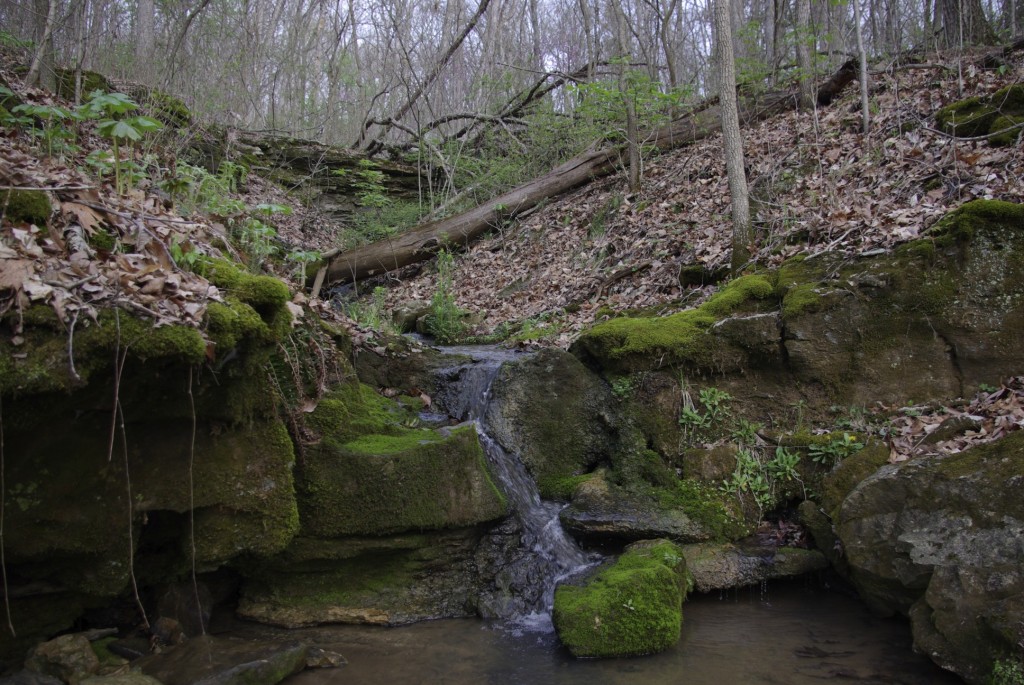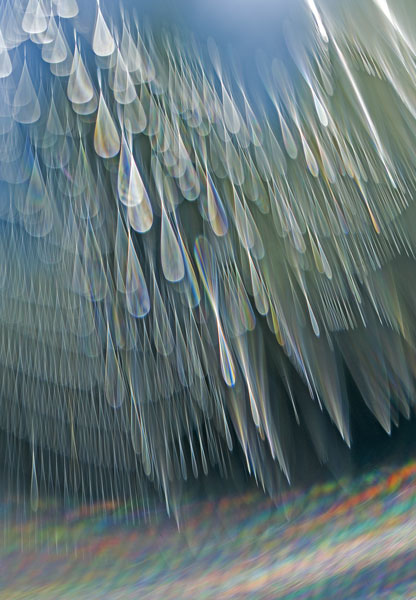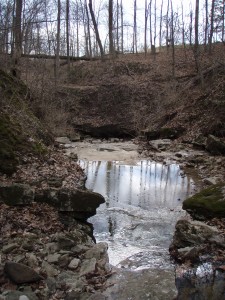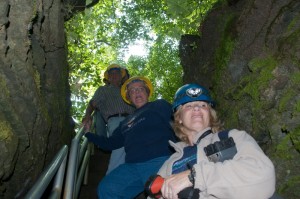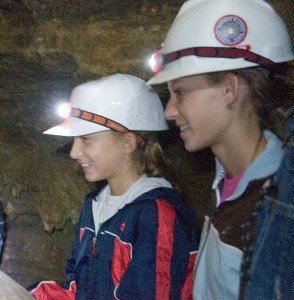What’s Underneath? Karst: Rugged and Beautiful
An amazing underworld lies beneath our bluff lands. Our region’s distinctive geologic history literally laid the groundwork for the area’s unique subterranean landscape, a rugged, yet beautiful topography called “karst.”
With the birth of the earth, processes began some 4 1/2 billion years ago, to build the globe’s crust and develop continents. Rocks and gravels resulting from volcanic activity (igneous rock) and the resulting actions of intense heat and pressure on those aggregates (metamorphic rock) gave rise to the earliest continental formations.
Beginning about one billion years ago, earth’s first continents rifted and began migrating to the equator. What was to become Illinois drifted along for the ride, a part of the North American plate.
From 360 to about 300 million years ago, our part of the state was covered by a vast, shallow and tropical inland sea. To the south, the shoal waters opened to the deeper ocean, with dry land areas found only well to the north of what eventually would be Southwestern Illinois.
Our land forms — above and below ground level — were the result of the slow accumulation of yet another rock form: sedimentary rock. Shallow water marine organisms built colonies from the sea floor up, each generation leaving their skeletal structures as new foundation platforms for the next inhabitants. In addition, the shells of marine animals accumulated on the sea floor. And, rivers that flowed into the shallow sea added mineral sediments that had dissolved in the fresh water as it coursed across exposed rock surfaces in the dry land areas. These ingredients — warm shallow waters teaming with coral-making and shelled creatures and the constant replenishment of mineral sediments — combined with time and the simple pressure of accumulated weight, created layered sedimentary limestone rock.
By 144 million years ago, continental migration resulted in Illinois resting where it is today. The vast sea then reached inland only so far as about modern-day Cairo. Monroe and Randolph Counties were not so very high in elevation, but were dry. The marine legacy left us with a 500 to 2500 foot thick limestone bedrock underlayment, filled with numerous, easily-viewed fossilized marine organisms as proof of our maritime heritage.
From 1.6 million through 10,000 years ago, Illinois and much of North America underwent several periods of glaciations — Ice Ages. Most of the state was repeatedly covered by massive blankets of ice. The glaciers carved out and smoothed the flatter land forms now typical of the Prairie State.
All the glaciers, however, stopped on the eastern fringes of our bluff lands. The bluff land corridor was not subjected to the scouring, smoothing and flattening action of direct glaciation. Because of this, our lands remained slightly higher in elevation than glaciated areas to the east and so our area is known as the Salem Plateau, a geographic extension of the also unglaciated Ozark region of Missouri.
This geologic backdrop set the stage for the karstification of our bluff lands. The thickly layered, but highly water soluble and thus easily dissolvable limestone bedrock was (and is) mantled by a water-permeable top soil. With the addition of slightly acidic water, our karst landscape was quickly created.
Rain in our area always is slightly acidic due to droplet formation around micro-particles of acidic soil and dust and because of carbon dioxide in the atmosphere. Our topsoils, slowly accumulated layers of pulverized rock dust blown to our area from winds howling down from the glaciers, are relatively thin and allow rain water to quickly pass through to the limestone bedrock. Rainwater percolating through our soil becomes even more acidic because of decayed vegetation. The chemical reaction between limestone and slightly acidic rainwater creates a weak solution of carbolic acid which helps to dissolve the limestone. Cracks and planes within the limestone bedding allowed conduits to form within the underlying layers. In time, conduits enlarged, some collapsed and, in a process that continues, several geological features came to characterize our karst terrain.
Dozens of springs; hundreds of caves, more than in any other county in Illinois, many of which harbor rare cave-adapted animals; and, thousands of sinkholes
can be found in Monroe County. There are a handful of “sinking streams,” which flow along the surface, disappear, and then reappear some distance later. There is no abracadabra to these streams: if we were able to see a cross section of the earth we would see the waters simply flowing — via gravity — to their lowest point, which, because of karst geology, is through a conduit in the limestone bedrock that remains underground.
The caves, springs, Houdini-like streams and sinkholes are all testimony to the cooperative nature of limestone in amplifying the trajectory and speed of water moving into our groundwater basins.
Those basins are organized into distinctly different recharge, or groundwater replenishment, areas in the bluff lands. A given recharge area is quite large and can vary in size from one to five thousand acres. Groundwater is funneled through conduits and caves, leached in through sinkholes, and generally remains within its given basin. It usually flows in the same direction as surface stream water. Groundwater may emerge as a spring and flow into a creek, and then flows out of its basin to the Mississippi or Kaskaskia Rivers.
But in our area inter basin transport of groundwater also occurs, with under ground water flowing in the opposite direction of surface flow. It then emerges in the springs of neighboring basins and groundwater areas. Our geology causes both rapid transport of water into groundwater and also can result in groundwater mixing across distances. In areas without karst geology, water moves slowly from the surface into groundwater — a lazy, steady, relatively uniform downward dripping — in a slow percolation through gravel, clay and sand soils which filter and purify the groundwater. In non-karst areas groundwater basins are largely isolated.
Given the size and interconnection of our groundwater recharge areas and the speed of water transport both into and through the subsurface, water pollution and soil erosion impact all bluff landers. Viruses, bacteria, excrement, chemicals and heavy metal concentrations can pass easily and essentially unpurified into and through our groundwater systems. Even the seemingly bright clear water flowing from a spring may include water that passed through a “wet” sinkhole used by cattle for hot-day lounging and drinking, or water that flowed through a “dry” sinkhole filled with abandoned car tires, batteries, trash and contents-no-longer-identifiable containers Filter strips, proper septic and sewage treatment systems, keeping sinkholes trash- and chemical-free — good neighborliness, in short — go a long way to sustaining water quality in our bluff lands. For while the greatest river of North America flows beside our lands, another river — hidden, and subterranean — runs under it.
Our lands — massive limestone bluffs that speak through the ages of the earth, a topography dotted with sinkholes, streams and springs that appear and disappear, caves that provide access to mysteries within the earth — are unique. Karst landscapes are rare on earth, and offer views of the dynamic processes of geology. Seeing karst from bottom-to-top — the underground view within a cave — offers both a lesson in earth’s physical structure and a view of scenic wonders.
Illinois Caverns Natural Area allows an up-close view of karst formation and offers insight into a delicate, and rarely seen biological cave community. The cave is home to invertebrates and a large number of cave-adapted animals.
Also known as Mammoth Cave of Illinois, Egyptian Cave, or Burksville Cave, the site was commercially operated during the St. Louis World’s Fair of 1904 and again in the 1940s. The State of Illinois purchased the site in 1985.
Clifftop hosted a public tour of Illinois State Caverns Natural Area, near
Burksville, on Saturday, August 23rd 2008. A local Professional Geologist and karst expert led the tour. The unimproved cave system, which was easily walked, required no climbing or crawling, excepting the entry ladder. Every participant brought and wore a hard hat and had three working flashlights. The cave is about 56 degrees (Fahrenheit) year round and is wet. Water depth is ankle-to-knee deep and participants dressed accordingly. Those who attended the field trip gained a better understanding of karst and found the tour informative and exciting!
Clifftop, a local nonprofit organization, is focused on preserving and protecting area bluff lands.
A version of this article appeared in the August 6 2008 edition of the Monroe County Clarion.
© 2008 all content rights reserved, Clifftop NFP.
Comments are currently closed.

